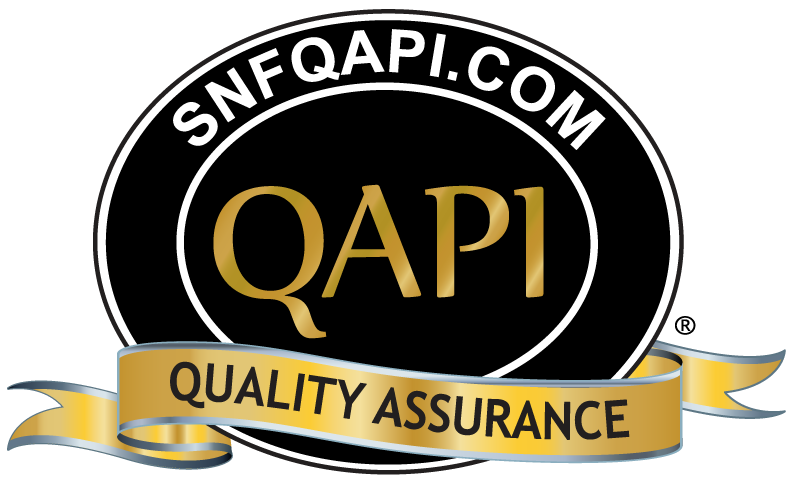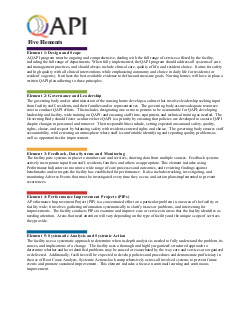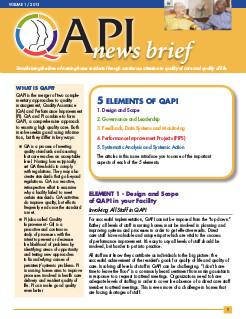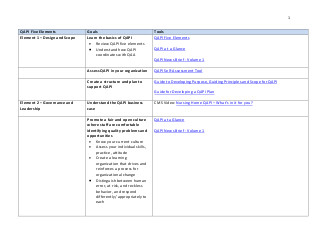Five Elements of QAPI
Element 2: Governance and Leadership
The governing body and/or administration of the nursing home develops a
culture that involves leadership seeking input from facility staff,
residents, and their families and/or representatives. The governing body
assures adequate resources exist to conduct QAPI efforts. This includes
designating one or more persons to be accountable for QAPI; developing
leadership and facility-wide training on QAPI; and ensuring staff time,
equipment, and technical training as needed. The Governing Body should
foster a culture where QAPI is a priority by ensuring that policies are
developed to sustain QAPI despite changes in personnel and turnover. Their
responsibilities include, setting expectations around safety, quality,
rights, choice, and respect by balancing safety with resident-centered
rights and choice. The governing body ensures staff accountability, while
creating an atmosphere where staff is comfortable identifying and reporting
quality problems as well as opportunities for improvement.
https://www.cms.gov/medicare/provider-enrollment-and-certification/qapi/downloads/qapiataglance.pdf

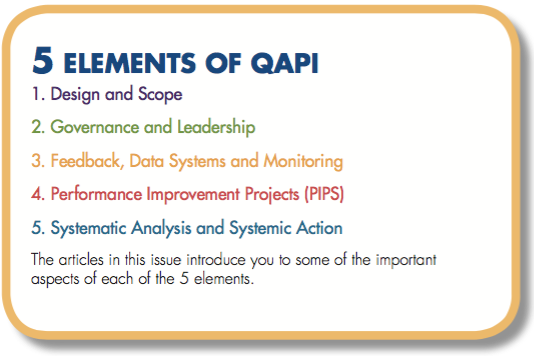
WHAT IS QAPI?
QAPI is the merger of two complementary approaches to quality management, Quality Assurance (QA) and Performance Improvement (PI). QA and PI combine to form QAPI, a comprehensive approach to ensuring high quality care. Both involve seeking and using information, but they differ in key ways:
- QA is a process of meeting quality standards and assuring that care reaches an acceptable level. Nursing homes typically set QA thresholds to comply with regulations. They may also create standards that go beyond regulations. QA is a reactive, retrospective effort to examine why a facility failed to meet certain standards. QA activities do improve quality, but efforts frequently end once the standard is met.
- PI (also called Quality Improvement - QI) is a proactive and continuous study of processes with the intent to prevent or decrease the likelihood of problems by identifying areas of opportunity and testing new approaches to fix underlying causes of persistent/systemic problems. PI in nursing homes aims to improve processes involved in health care delivery and resident quality of life. PI can make good quality even better.
ELEMENT 2 - Governance and Leadership
How to Engage Residents and Families in QAPIResidents should have control over their lives, influence decisions which affect them, and know that their opinions and preferences matter. The autonomy, individuality, and dignity inherent in this goal are all part of quality of life. The opinions and priorities of individual residents and family members should guide QAPI. Residents and families can identify quality of life and care issues important to them, and provide feedback on their experiences. Residents and families may also have structural roles in QAPI—they can serve on performance improvement project (PIP) teams and Steering Committees. Residents and families have unique perspectives and can facilitate communication with staff and bring in new ideas.Consider using your Resident Council as a source of input for QAPI. The following questions may be helpful as you consider how to involve residents and families in QAPI:
- How do you regularly ask for feedback from residents and families? Remember that QAPI Element 3—Feedback, Data Systems, and Monitoring—requires that some of your data are derived from feedback from residents and families.
- Do you investigate resident and family complaints and generate action plans if validated?
- How do you create a climate where residents and families are comfortable raising issues?
- Do you have a resident and/or family council that can help individuals speak in a shared voice to effect change
- Do you address the concerns raised in resident and family council?
- Do you have, or would you consider having a resident and/ or family member on your Quality steering committee?

For QAPI to thrive, nursing homes need to create an environment that balances safety and accountability with fairness and openness. Nursing homes should facilitate communication by adopting a nonpunitive response to medical errors and near misses. They should not adopt a blameless system where no one is held accountable for reckless or careless behavior or intentional rule breaking. Rather, employees should feel comfortable coming forward with useful information in the interest of system safety.

|
QAPI Five Elements |
Goals |
Tools |
|---|---|---|
|
Element 2 – Governance and Leadership |
Understand the QAPI business case |
CMS Video: Nursing Home QAPI – What’s in it for you? |
|
Promote a fair and open culture where staff are comfortable identifying quality problems and opportunities
|
QAPI at a Glance QAPI News Brief - Volume 1 | |
|
Create a Culture that embraces the principles of QAPI |
QAPI at a Glance QAPI News Brief - Volume 1 QAPI Leadership Rounding Tool | |
|
Promote engagement and commitment of staff, residents and families in QAPI |
QAPI at a Glance QAPI News Brief - Volume 1 Examples of Performance Objectives for Job Descriptions and Performance Reviews | |
|
Involve residents and families
|
QAPI at a Glance QAPI News Brief - Volume 1 |
